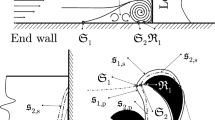Abstract
This paper reports on the investigation of steady wake effects in cascades. An annular cascade rig, where two stators having the same blade pitch can be circumferentially traversed relatively to each other, is used to analyse the profile losses and the boundary layer development of the downstream stator for different circumferential positions of the upstream stator (“clocking positions”). Different measurement techniques are used such as three-hole pressure probes, and hot wire- and surface-mounted hot-film probes. The results show a varying pressure loss coefficient of the downstream cascade (S2) for different clocking positions of the upstream cascade (S1_SP).
















Similar content being viewed by others
Abbreviations
- c :
-
Flow velocity in absolute frame of reference
- c m :
-
Mean flow velocity
- clp :
-
Clocking position
- Cp:
-
Static pressure coefficient
- E :
-
Anemometer output voltage
- E 0 :
-
Anemometer output voltage at zero velocity
- G :
-
Threshold for intermittency calculation
- k1:
-
Turbulent kinetic energy
- l(t):
-
0/1-distribution for intermittency calculation
- Ma c :
-
Mach number based on absolute velocity
- P :
-
Static pressure
- P tot :
-
Total pressure
- PS :
-
Pressure side
- S1_SP:
-
Stator 1
- S2:
-
Stator 2
- t :
-
Pitch, time
- T :
-
Measuring time
- S :
-
Surface length coordinate
- S(t):
-
Detector function
- S*(t):
-
Smoothed detector function
- S ges :
-
Total surface length
- SS :
-
Suction side
- x :
-
Circumferential coordinate
- α :
-
Flow angle
- γ :
-
Intermittency
- ω :
-
Loss coefficient
References
Acton P (1997) Untersuchungen des Grenzschichtumschlages an einem hochbelasteten Turbinengitter unter inhomogenen und instationären Zuströmbedingungen. Dissertation, Universität der Bundeswehr, München
Arnone A, Marconcini M, Del Greco AS, Spano E (2003) Numerical investigation of three-dimensional clocking effects in a low pressure turbine. ASME Turbo Expo, GT2003-38414
Binder A, Schröder T, Hourmouziadis J (1989) Turbulence measurements in a multistage LP-Turbine. ASME J Turbomach 111:153–161
Breitbach C, Stoffel B (2001) Computation of wake-induced unsteady flow on a flat plate using two-layer turbulence models. In: Proceedings of the 8th international symposium on flow modelling and turbulence measurements, FMTM2001, Tokyo
Chakka P, Schobeiri MT (1999) Modelling unsteady boundary layer transition on a curved plate under periodic unsteady flow conditions: aerodynamic and heat transfer investigations. ASME J Turbomach 121:88–97
Dorney DJ et al (1999) Full-annulus simulations of airfoil clocking in a 1 1/2 stage axial compressor. Int J Turbo Jet Engines 16:149–160
Dorney DJ, Sharma OP (1996) A study of turbine performance increases through airfoil clocking. AIAA Paper 96-2816
Dorney DJ, Sondak DL, Stang UE et al (2001) Computational study of clocking in an embedded stage in a 4-stage industrial turbine. ASME Paper 2001-GT-0509
Engber M, Fottner L (1995) The effect of incoming wakes on boundary layer transition of a highly loaded turbine cascade. In: Proceedings of the AGARD PEP 85th symposium on loss mechanisms and unsteady flows in turbomachines, CP-571
Eulitz F, Engel K (1998) Numerical investigations of wake interactions in a low pressure turbine and its influence on loss mechanisms. ASME-Paper 98-GT-563
Gostelow JP, Thomas RL (2003) Response of a laminar separation bubble to an impinging wake. ASME Turbo Expo, Atlanta, GA, 16–19 June, GT2003-38972
Griffin LW, Huber FW, Sharma OP (1995) Performance improvement through indexing of turbine airfoils. Part 2: Numerical results. ASME Paper 95-GT-28
Haldeman CW, Krumanaker ML, Dunn MG (2003) Influence of clocking and vane/blade spacing on the unsteady surface pressure loading for a modern stage and one-half transonic turbine. ASME Turbo Expo, GT2003-38724
Halstead DE et al (1997) Boundary layer development in axial compressors and turbines. Part 1: Composite picture. ASME J Turbomach 119:114–127
Heinke W (2002) Experimentelle Untersuchungen zum Clocking-Effekt an einer stationären Stator-Stator-Anordnung. Dissertation, TU Darmstadt
Heinke W, Stoffel B, Heinig K, Fiala A (2000) Numerische Simulation und experimentelle Untersuchungen zum Clocking-Effekt. Tagungsband des Siebten Statusseminar Verbundprojekt C02-armes Kraftwerk, pp 11.1–11.12
Höhn W, Heinig K (2000) Numerical and experimental investigation of unsteady flow interaction in a low-pressure multistage turbine. ASME J Turbomach 122:628–633
Hourmouziadis J, Lou W (2000) Separation bubbles under steady and periodic-unsteady main flow conditions. ASME J Turbomach 122:634–643
Huber FW, Sharma OP, Gaddis SW (1995) Performance improvement through indexing of turbine airfoils. Part 1: Experimental investigation. ASME Paper 95-GT-27
Jouini DBM, Little D, Bancalari E, Dunn M, Haldeman C, Johnson PD (2003) Experimental investigation of airfoil wake clocking impacts on aerodynamic performance in a two stage turbine test rig. ASME Turbo Expo, GT2003-38872
Ladwig M (1991) Experimentelle Untersuchungen zum Einfluß einer inhomogenen Zuströmung auf die Entwicklung des Strömungsfeldes in Turbinenschaufelgittern. Dissertation, Universität der Bundeswehr, München
Marconcini M, Pacciani R (2003) Numerical investigation of wake-shock interactions and clocking in a transonic HP turbine. ASME Turbo Expo, GT2003-38401
Reinmöller U, Niehuis R (2002) Clocking effects in a 1.5 stage axial turbine-steady and unsteady experimental investigations supported by numerical simulations. ASME J Turbomach 124:52–58
Stadtmüller P, Fottner L, Fiala A (2000) Experimental and numerical investigations of wake-induced transition on a highly loaded LP-turbine at low Reynolds numbers. ASME Paper, 2000-GT-0269
Walker GJ, Hughes JD, Solomon WJ (1998) Periodic transition on an axial compressor stator incidence and clocking effects. Parts I, II: ASME Paper, 98-GT-363 and 98-GT-364
Acknowledgements
The present investigation was partly financed and carried out as a part of the German Research program AG TURBO II under the leadership of the German Ministry of Economics and Labour. Further, we would like to acknowledge the financial and technical support of MTU Munich and their scientific advice.
Author information
Authors and Affiliations
Corresponding author
Rights and permissions
About this article
Cite this article
Heinke, W., König, S., Matyschok, B. et al. Experimental investigations on steady wake effects in a high-lift turbine cascade. Exp Fluids 37, 488–496 (2004). https://doi.org/10.1007/s00348-004-0832-0
Received:
Accepted:
Published:
Issue Date:
DOI: https://doi.org/10.1007/s00348-004-0832-0



